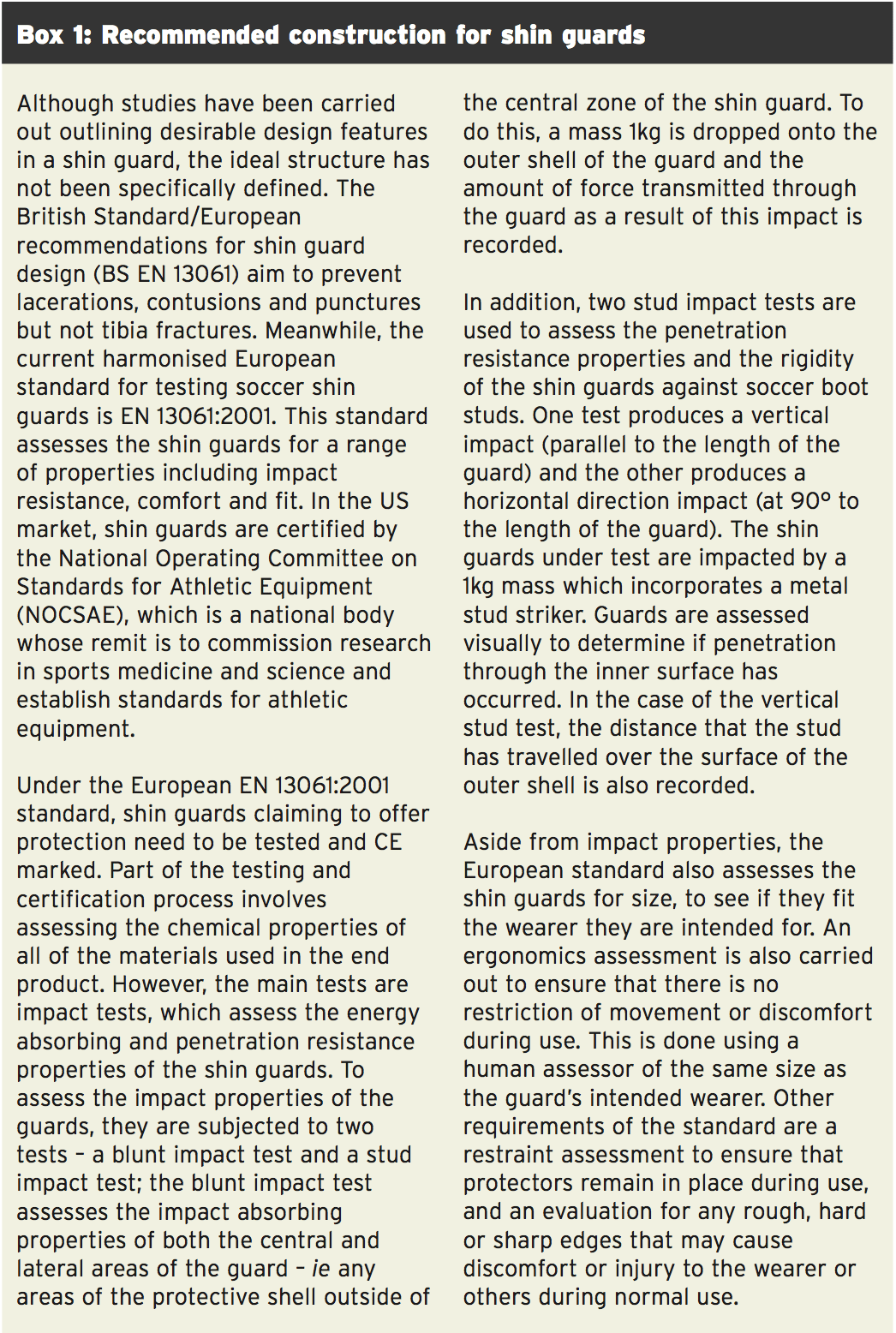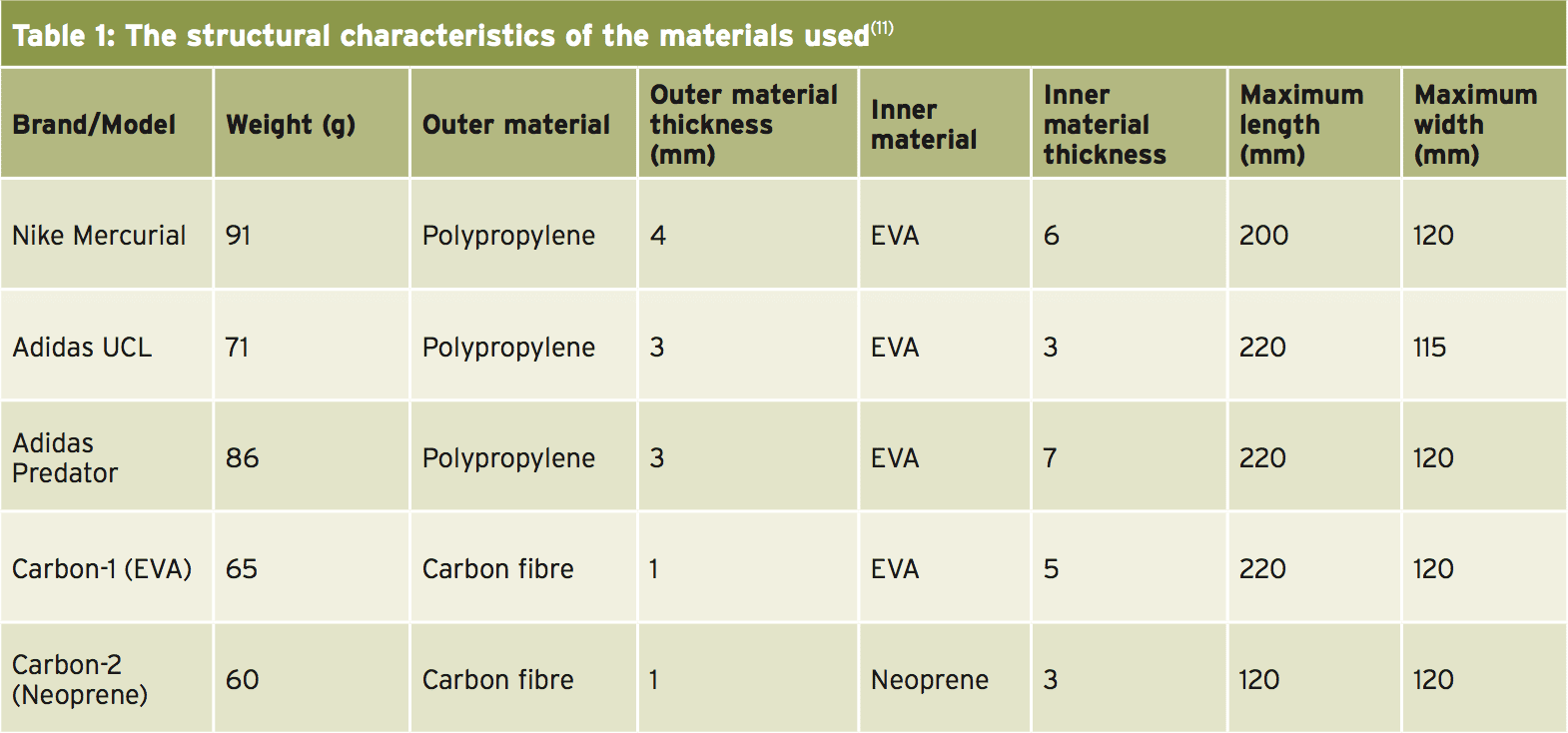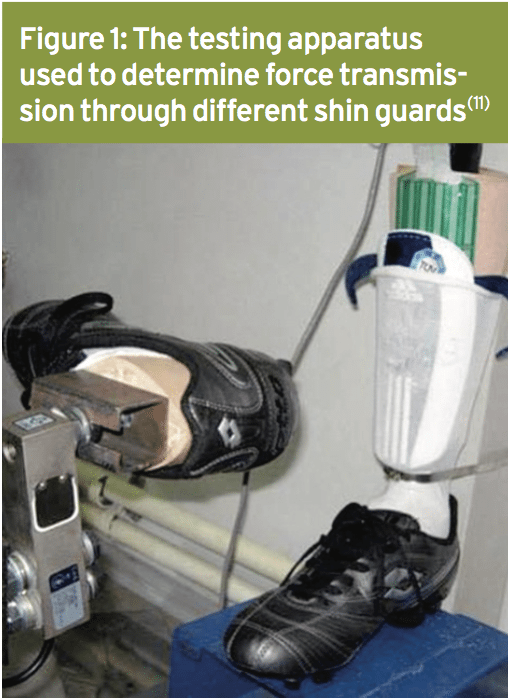Injury scientist, Dr. Alexander Jimenez looks at shin guard use in soccer. Just how successful are guards in preventing lower limb injury and which provide the most protection?
Soccer is the most popular team sport in the world, so it is hardly surprising there- fore that there's much interest and effort into managing and reducing the injury risks associated with 'the beautiful game'. The most frequent injuries in football players are muscle strains and tears, ligament damage and contusions caused by impacts(1). Although these types of injuries are highly undesirable, fractures are even more serious; a fracture always contributes to a prolonged lay-off and can sometimes even be career- threatening. The data shows that fracture accidents represent between 2-11% of all soccer injuries among players, and that lower extremity fractures account for 30-33% of all fractures sustained(2). Given the risk, as a result, the use of shin guards in football to prevent lower leg injury (both fracture and soft tissue) is now routine.
The function of shin guards is to protect bones and the soft tissues in the lower extremities from external impact. Shin guards provide shock absorption and facilitate energy dissipation. In 1994, the International Federation of Association Football (FIFA) created FIFA's Medical Assessment and Research Centre (FMARC) to investigate and to stop soccer-associated risks to players' health. FMARC proposed that guard use was a preventive method of reducing injury risk.
However, even though a number of studies have concluded that shin guards can significantly decrease the amount of minor injuries(3), there's still some debate in the literature regarding whether they can prevent more serious injuries such as tibia fractures(4), particularly as tackles causing injuries often create tears or damage to the shin guard. By way of example, 1 study investigated impact forces acting on shin guards protecting simulated tibias (wooden slats) and compared these to non-protected ones(5). It concluded that the shin guards spread the impact forces over a longer time period, thus reducing the peak effect (most damaging) force. When greatest forces were below 3,000 N, the protective effect was observed. At higher forces -- the force that can fracture a tibia -- defense was far less efficient. The authors concluded therefore that shin shield usage was most likely to be useful for protecting against soft tissue injuries.
A later study used dummies to evaluate the effectiveness of shin guards in attenuating the forces which can lead to lower extremity injuries(6). One player being kicked by another was simulated by A pendulum impact apparatus, with impacts delivered to the anterior tibial region of the dummy. The researchers found with the shin guards in place, that the load forces were reduced by between 41 and 77% -- a reduction. Despite their results, however, they were not able to conclude that shin guard use could reduce the risk of tibia fracture.
Shin Guard Design
There's still a rationale for their use, even though the evidence regarding the ability of shin guards to prevent fracture is somewhat limited. All shin guards aren't created equal, which begs the question, 'Just what is a good shin guard design?'This isn't a simple question firstly, players come in all shapes and sizes, so a design that feels comfortable and provides a good fit might not be suited to another. Then, of course, it is impossible to collect data on injury protection under controlled laboratory conditions because it is unethical to ask a soccer player to sit in a laboratory wearing a shin guard when subjecting his/ her shin to blows in order to see the kind and seriousness of the injuries sustained!
Despite these issues, however, a number of studies utilizing shin models and shin guards have been completed, giving rise to a generalized recommendations. In the simplest terms, use of an appropriate shin guard material, along with the proper geometry are known to be important aspects of shin guard design(7) To achieve this, using rigid materials (vinyl, carbon, Kevlar, etc) are universally used to form the outer shell in modern shin guards, while soft materials are preferred for the lining of the guard. The criteria have been established:
- A well-designed shin guard should provide sufficient protection for the shank, but allow adequate range of motion of the ankle and the knee(8);
- To increase energy absorption, the shin guard shell should be thick and inflexible in the transverse direction, but an increase in shin guard length does not provide better shock absorption(9-10);
- Adding the shin guard to the tibial geometry by adding soft material (eg foam) or air bubbles can reduce the peak impact force(9). Some researchers have even suggested filling such gaps with semi-rigid materials(10).
Carbon: The Way Forward?
The standards criteria were devised to reduce the risk of injury to a participant's lower leg that could be caused by a striker's cleats. But, the consequences that were related and high-energy impacts weren't taken under account, and this has led some researchers to ask whether the recent designs could be improved against fracture, especially to improve security. In a newly-published study, scientists have tried to answer precisely this question by examining three leading branded shin guards as well as two custom designs constructed out of carbon fibre(11).In this study, two Adidas shin guards (Addidas Predator and Adidas UCL) have been tested alongside one from Nike (Nike Mercurial) as well as two custom-made carbon fibre shin guards (see Table 1 above for a summary of the shin guards' construction). There was with pendulum movement A device designed, which was capable of producing large impact forces. The effect mechanics used in this experimental setup was designed to hit the shin guard by the heel of the foot (an area of about 20cm2) -- see Figure 1. The impact values sent to artificial tibias (prepared by condensed foam and reinforced by carbon fiber and protected with soft garments -- to yield natural anthropometric properties) have been listed for a wide assortment of forces, from low to very high. The forces were recorded under the shin guards, which provided a realistic reflection of the injury risk during soccer tackles that were real from a number of sensors.
Results
Low Impact Force (LIF) -- In the LIF trials, 2.8-9.6 percent of this load was transmitted through the shin guards to the detectors on the artificial tibia. Of the five shin guards analyzed, the highest transmitted force was significantly lower when the two carbon fiber guards were worn (ie these provided more protection) and each of those carbon guards was equally as powerful as the other. Of the three versions the Nike Mercurial shin shield provided better protection than either the Adidas Predator or the Adidas UCL, which performed.High Impact Force (HIF) -- At the HIF trials 5.2-10.9% of the load was transmitted to the detectors on the artificial tibia. Again, the urge and the force were significantly lower for the carbon shin guards than for the three poly- propylene versions -- typically around load. This time there were no significant differences in the maximum force although the investigators noticed that wearing the Adidas Predator guard led to a longer urge time over which the force acted transmitted through the Nike Mercurial guards, Adidas UCL and the Adidas Predator. Importantly, the nearly 3000N force required to produce fracture was not 262N -- much lower than the highest recorded impact force in any of the tests.
From their findings, the researchers were able to draw a number of conclusions about shin guard design:
- When carbon fibre shin guards were used, impact forces and values diminished in trials. The fact that the carbon models were shown to be exceptional was attributable to the inherently rigid character of carbon fiber (which deforms less) and to their custom-made design, which hugged the shin more efficiently, spreading the load out.
- Shin guards for longer bend more because of their structure, which means forces acting on the tibia tissue.
- Both the ridge of the lining of the Nike Mercurial model and the shell were thicker than those of the Adidas UCL, which resulted during the LIF trials in a performance that is superior.
- The load transmitted onto the front of the tibia was significantly below the load level needed to fracture the tibia. Although the force can exceed those the evidence suggests that all the tested shin guards could provide a degree of protection.
Summary & Conclusions
In summary, then, this study offers evidence that a tibia protected by a shin guard is not likely to sustain a fracture of course, that the shin guard comes between the player's shin and the competitor's boot! Having said this, the forces transmitted via a shin guard are adequate to result in soft tissue injury and in this regard, carbon shin guards seem to offer protection when coupled with an EVA lining. Whatever the lining or shell material, any shin guards should conform to the European standard and be sized to ensure a match that is good that both and the shin hug and feels comfortable in use.References
1. British Journal of Sports Medicine 1999; 33, 196-203
2. British Journal of Sports Medicine 1996; 30, 171-175
3. American Journal of Sports Medicine 1982 10, 75-78
4. Clinics in Sports Medicine 1998; 17, 769-777
5. Z Orthop Ihre Grenzgeb. 1985 NovDec;123(6):951-6
6. Clin J Sport Med. 1995;5(2):95-9
7. “The biomechanics of soccer surfaces and equipment”. In: Science and Soccer. 1st edition (1996). Ed: Reilly, T. Taylor & Francis Group. 135- 150
8. “The prevention of injuries in youth soccer”. Michigan Governor’s Council on physical fitness, health and sports http://files.leagueathletics.com/Images/Club/6097/The%20Prevention%20of%20injuries.pdf
9. American of Journal Sports Medicine 2000; 28, 227-233
10. Sports Engineering 2003; 6, 207-220
11. Journal of Sports Science and Medicine (2014) 13, 120-127







